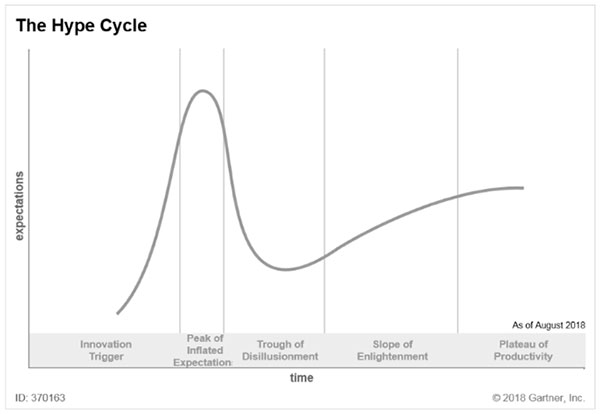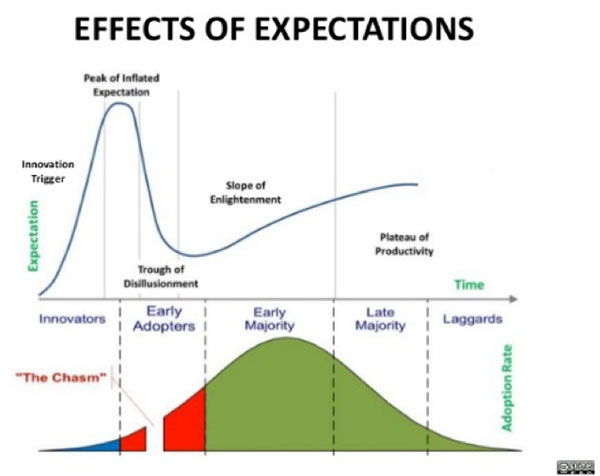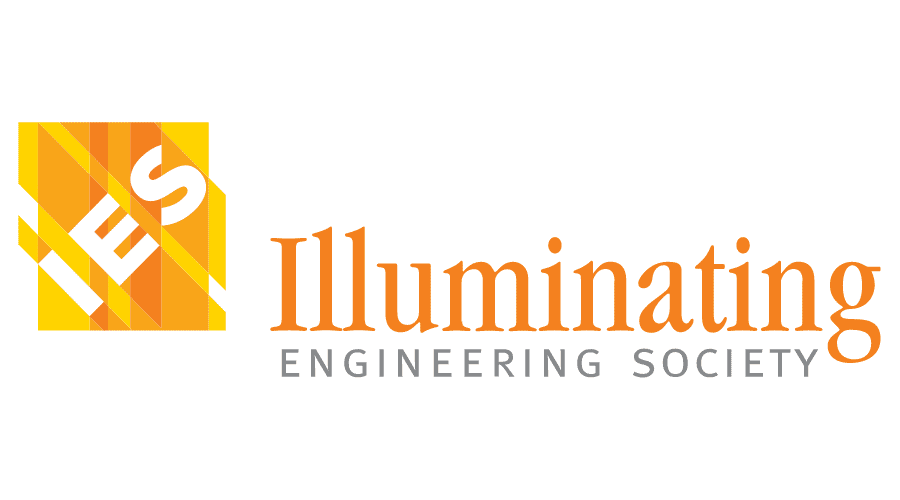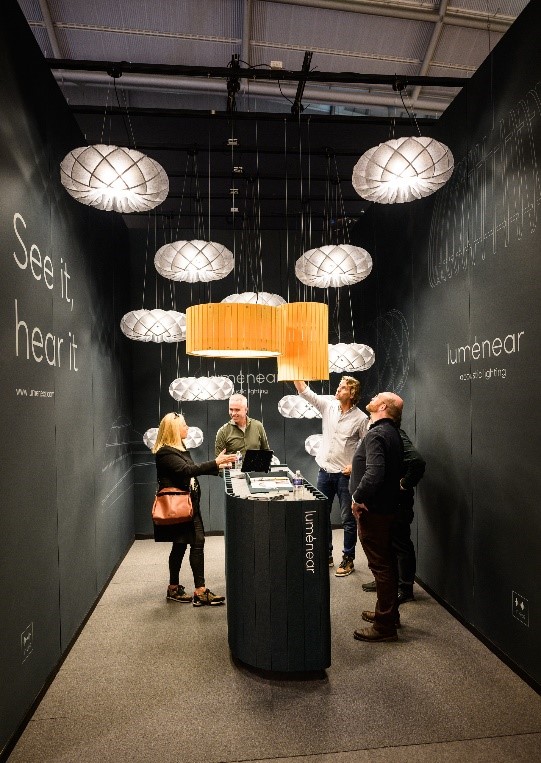Editorial Disclaimer
The views expressed in articles published on FIRES do not necessarily reflect those of IES or represent endorsement by the IES.
By Colleen Hufford, LC, IES
Kelly Seeger, MSc, LC, IES, LEED AP
Signify
Arguably, the biggest challenge we face (as an industry) is how to successfully apply circadian science to garner real, demonstrable benefit for people. As manufacturers, we are challenged with figuring out the technical specifications—the recipes, so to speak—to create lighting products and systems that deliver circadian benefit. Lighting designers are tasked with creating and installing lighting designs that ultimately realize and deliver those benefits, incorporating lighting systems into their design strategies to achieve the recommendations of the scientific findings to facilitate circadian regulation. In this article, we draw parallels to recognized principles of technology and innovation cycles to provide a framework for the current state of the lighting industry and share insights from our distinct vantage points on how to move the industry toward realization of its goals.
Introduction
Since the energy crisis of the 1970s, the lighting industry has been largely focused on energy efficiency—from significant technological development in light sources and controls, to product efficiency regulations, to energy codes that set minimum requirements for the installation of lighting systems in buildings. Lighting performance has been tempered by the mandate to improve energy efficiency and, as a result, has been confined to its relation to visual acuity: provide enough light on the work plane while using the least amount of energy possible.[1] This energy efficiency-minded view of lighting as the “lowest hanging fruit” has slowed the growth and development of the benefits of lighting beyond visual.
Nearly fifty years later, we find ourselves in a very exciting yet challenging time in the lighting industry, in the midst of a digital revolution where the number of addressable applications is exploding and the desire to harness light to support human health and wellbeing is coming to prominence. Technology gains are quickly expanding and opening new applications, from the ability to transmit data via LiFi, to tracking and optimizing building usage, to monitoring luminaires and optimizing maintenance schedules, to tuning the correlated color temperature (CCT), color rendering index (CRI), and other spectral properties of luminaires.
There is no doubt as to the important role that light plays within the human experience. Illumination can instill a sense of safety, provide wayfinding, and create ambiance in a space. It supports human interaction and communication, helps businesses sell products, optimizes food nutrition and plant growth, and supports health and well-being.
Relating the Gartner Hype Cycle to the Current Situation in the Lighting Industry
The Gartner Hype Cycle portrays a common pattern of hype, disillusionment, and understanding for technologies and innovative concepts[2] that can be aligned to the lighting industry and its desire for delivery of non-energy benefits via lighting through connected systems.
The curve in Figure 1 illustrates the effects of expectation in the development of disruptive technologies.[2] Gartner identifies four stages of expectation that a technology progresses through in its march toward realization, wide-scale adoption, and customer acceptance in the marketplace. Worth noting is that if Gartner’s effects of expectations curve is overlaid on top of Geoffrey Moore’s Technology Adoption Life Cycle as seen in Figure 2, the trough of disillusionment (which we’ll talk more about below) aligns with the point at which the technology or innovation must “cross the chasm” from early adopters to early majority to secure success.[3,4]


The Lighting Innovation Trigger
In the Innovation Trigger stage, the technology or innovation arrives and is extolled for all its potential. Concern for its downsides and possible barriers to market adoption are minimized, and this is the beginning of the hype that’s created. The hype starts to build immediately and swiftly, leading to inflated expectations.
The discovery of melanopsin in the African clawed frog in 1998 by American neuroscientist Ignacio Provencio triggered an intense wave of interest in how light could go beyond facilitating sight—and impact health and well-being of people.[5] Since then, much has been discovered about the biology, neuroscience, and behavioral science behind circadian rhythms and the ability of light to entrain circadian rhythms in humans, thus growing market appeal and demand.
Because the science of light and health has exploded over the last few years—and scientists are currently focusing on many aspects of the research and are far from completion—it’s important to characterize what we know. Put succinctly, these five key points sum up the established, accepted science to this point:
- Light impacts people through image forming and non-image forming pathways to the brain.[6]
- There are five different photoreceptors in the retina, each with different spectral sensitivities that impact human visual and non-visual responses. They are rods, short-wavelength cones, medium-wavelength cones, long-wavelength cones, and melanopsin-containing intrinsically photosensitive retinal ganglion cells (ipRGCs).[7]
- There at least five different types of melanopsin containing ipRGCs in the human retina. These are diverse types of ganglion cell photoreceptors in the mammalian retina, and at least 15 distinct pathways between the retina and brain have been discovered. Mice have recently been found to have a sixth melanopsin type, suggesting that further insights into the mammalian retina may be on the horizon[8,9,10, 11,12]!
- Some ipRGC types connect to the circadian pathways in the brain, while other types regulate image forming pathways in the brain.[13]
- Five things about light impact human circadian entrainment: light spectrum, amount of light, timing of the light stimulus, duration of the light stimulus, and distribution of the stimulus.[14]
The Peak of Inflated Expectations
The second stage in the hype cycle, the Peak of Inflated Expectations, is the height of this unbridled optimism for the innovation. It’s impossible to stay at the peak for long, though, and this results in a severe dive into the trough of disillusionment, the third stage.
When Apple enabled the “night shift” feature on their phones and tablets in March of 2016, it brought “circadian” into the common lexicon. It set a new expectation, both inside and of outside the lighting community, that removing blue light was a commonly held, scientifically accepted solution for the populace to help improve sleep.
Since 1998, researchers have been developing circadian science according to biology, neuroscience, population differences, age differences, and applications. The positive results of many of these studies have not only raised expectations of the benefits of the science but have also inflated marketplace expectations around a false belief that the science is “fully cooked” and complete enough for product implementation in all application types (which it is not), and that it is better than standard illumination practices for all applications (which is also unproven).
The Trough of Disillusionment
From the Peak of Inflated Expectation, we dive into the Trough of Disillusionment where the same few success stories are repeated, companies are struggling to drive meaningful value, and the media has turned to highlighting challenges instead of opportunities. This disillusionment has also manifested in the significant backlash against LED technology, particularly around blue light inclusion. The most notable example has been the American Medical Association guidelines adopted in June of 2016, which provide guidance on the use of LED technology in outdoor applications because of what it saw as “potential harmful human and environmental hazards.” While the IES, NEMA, and other organizations disputed the guidelines, the results from this controversy were far reaching, as they garnered attention from major news outlets, raising significant awareness in the general population around blue light and sleep.
The increase in knowledge on this topic by the general population has rushed lighting professionals to convert indoor environments to circadian lighted spaces in order to negate perceived negative effects of blue light, with limited success. Lighting designers are being asked to design lighting installations using recommendations built on in progress circadian science; manufacturers are being asked to provide innovative products and solutions that deliver real benefits; and certain standard-developing bodies are being asked to lead market transition by setting standards and guidance, which may only be applicable under some conditions.
The constant barrage of research study results available in our modern age of real-time communication is overwhelming. Time is needed to review, digest, and decide whether the results can and should be included in the larger accepted body of science. Since various research groups are working on how to quantify the five aspects to optimize human circadian entrainment for specific populations, the industry does not have one agreed upon recommendation or metric to work with, much less population-specific or application-specific guidance for designers.
The Slope of Enlightenment
But there is hope, and we may well be into the early stages of climbing the Slope of Enlightenment as the research begins to mature into a cohesive body of evidence, the gaps are being addressed and the challenges worked on, and the early adopters are swelling into an early majority.
Everett Rogers, who pioneered the “Diffusion of Innovations” Curve, stated that 2.5% of those who embrace a new technology are the very early innovators, 13.5% are the early adopters, and 34% the early majority[15]. The early majority aren’t quick to try new technology and often rely on recommendations from those who have used the product already. The innovators and early adopters are the ones to spread the word about the product. Early adopters have the highest degree of opinion leadership and realize that judicious choice of adoption will help them maintain a central communication position. It’s time for the lighting industry to “cross the chasm.”
Insights from the Field – Colleen
Having globally accepted metrics for supporting circadian rhythms with lighting makes a lot of sense to me as a product manager and allows me to design products for multiple markets and meet agreed-to goals. Similarly, this would be important to lighting designers who design lighting for people in buildings in many applications and markets around the world. In order to produce real-world products throughout the world that support human centric lighting and deliver benefits, we need a single standard that uses a simple model, is based on scientific consensus, complies with the SI system of units, and (here’s the key) can be adapted and extended to allow for enrichments of new scientific insights (i.e., is “future-proof”). The international standard, CIE S 026, CIE System for Metrology of Optical Radiation for ipRGC-Influenced Responses to Light fits the bill as an international standard to quantify light for biological effects that has been developed from scientific insights with global consensus.
While there have been several metrics proposed to quantify light for responses beyond vision, there is now global scientific consensus behind two building blocks included in CIE S 026: melanopic daylight efficacy ratio (melanopic DER) and melanopic equivalent daylight illuminance (melanopic EDI). Melanopic DER is a measure that indicates whether the spectrum of a light source has an equal, larger, or smaller melanopsin stimulation, compared to standard daylight (D65). Melanopic EDI is the product of melanopic DER and the amount of light (illuminance) on the eye, an indication of how suitable the light is to support the biorhythms of people. Equivalent melanopic lux (EML), the metric many are familiar with since it is utilized in the first version of the WELL building standard, is a predecessor of melanopic EDI, while the M/P value is a predecessor of melanopic DER.
Melanopic EDI gives us the tools to quantify the different levers that lighting designers must pull when designing a space: the spectral content of the light and the amount of illuminance at the eye. This metric quantifies the effect on each of the receptors: rods, l-cones, m-cones, s-cones, and melanopsin-containing ipRGCs. This setup allows the model to easily be extended in the future as the scientific consensus on more complex photoreceptor interactions emerge. This is particularly important since the research appears to show that the image-forming and non-image forming systems work in tandem.
Lighting designers can start using melanopic DER to choose sources that provide a high proportion of melanopic light during times when they want to help stimulate the circadian system, and a low proportion when suppression is desired. With the popularity of the WELL building standard and its incorporation of EML, the popularity of implementing circadian lighting systems in the field has grown. It would be a positive and natural extension for WELL to include melanopic EDI and melanopic DER in the final version of WELL v2.
Insights from the Field – Kelly
As someone heavily involved in developing codes and standards for lighting and energy usage in buildings in the U.S., I believe that we need a mindset overhaul—and it’s not just the lighting industry that needs to evolve, but also the broader building design and construction industry. The laser focus that we’ve had on energy efficiency and reducing energy consumption for lighting, coupled with ever-tightening, more stringent, more complex requirements for lighting, has played a central role, if not the central role, in lighting system development for years. While it has led to tremendous leaps in source efficacy, luminaire efficiency, and controls, it has significantly held back lighting innovation because energy efficiency has been the primary consideration.
A noticeable effect of this is the “gray area” we see in applying existing U.S. energy code requirements for commercial buildings to connected lighting system innovations that don’t fit squarely within the established requirements. If you are a building inspector and you’re not sure you can check off all the lighting compliance boxes on my building (e.g., design doesn’t exceed LPD limits; local control, automatic shut-off control, daylighting control, and/or dimming control is installed), then that’s a problem. An unintended result of this has been for the manufacturing community to try to steer clear of innovation that is in the “gray area.” For example…
- …Your open office lighting system features behavior that is automatic and granular, and you don’t want to install manual control because it would interrupt the operation sequencing, and no one is going to use the light switch in an open office anyway because it’s shared space? Sorry, this does not comply; you must install local control.
- …Your lighting system varies the intensity of the light throughout the day to produce different horizontal illuminance levels, and so the LPD for the space fluctuates? Sorry, this does not comply because you must be below the prescribed LPD for the space.
- …The light levels achieved by your lighting system factor in the contribution from daylight, so you don’t want to install daylighting controls to reduce or turn off the electric lighting when daylight availability exceeds 150% design illuminance? Sorry, this does not comply; you must install automatic daylighting controls and reduce electric light when sufficient daylight is present.
Summary
Examples like these are growing in practice, and we are now to the point that the exception in many cases is the rule and can result in a risky scenario from a liability standpoint for lighting designers, installers, and manufacturers. It shouldn’t be about fitting innovation and our goals for good lighting for people into the entrenched standards and regulations; it should be about reimagining and recrafting these standards and regulations to protect and promote good lighting. We need the right light, not the bare minimum amount of light. We should transition our lighting energy codes into standards that are more like application norms, are separate from the building codes, and are backed by new legislation legitimizing the benefits of good lighting. By good lighting we mean lighting that provides visual and nonvisual benefits in an energy-responsible manner—lighting that is attractive, dynamic, optimized, and personal. The goal of standards and regulations has never been to prevent or thwart innovation, but that is exactly where we find ourselves—with an overly complex system that we have to comply with on many levels, from the product level to the building level, that is not well enforced, and that has requirements which are now in serious conflict with innovation.
The lighting industry has achieved very highly efficient, consistently well-performing, safe lighting products at all market levels and in all segments, so the time has arrived to now focus on regulating the actual energy outcomes for buildings and considering the contribution of building systems in aggregate. We should move away from installed power and adopt whole-building energy use intensity (EUI) strategies that regulate all building energy from occupant amenity loads (e.g., lighting, HVAC) to process loads (e.g., office equipment, industrial machinery) to miscellaneous electric loads and plug loads. Innovation in lighting has delivered a reduction in energy usage of more than 90 percent compared to 1973[1] and is no longer “the low hanging fruit.”
In addition to a change of mindset and new codes and standards that recognize the benefits of good lighting, we also need IES as the lighting authority to take on a larger and more meaningful role in the application of circadian science. A great first step would be adopting a new education model in which the IES Light and Human Health Committee—in a quarterly newsletter that is distributed far and wide—regularly shares new research insights and helps to make connections and build the body of accepted science and what it means. The research insights are just coming too fast; typical modes of education such as by sections, webinars, and seminars at yearly conferences are simply insufficient. It would also be beneficial for all stakeholders to be aware of anticipated publication timelines and linkage with CIE Standards development.
Let’s work together and cross the chasm to bring the real-world application of circadian science and the nonvisual benefits of lighting into the mainstream.
References
[1] Benya, J. “Our Work Here is Done.” Hot Topics, Illuminating Engineering Society, 14 May 2018, https://www.ies.org/lda/our-work-is-done-here/
[2] Fenn, J. and M. Blosch. “Understanding Gartner’s Hype Cycles.” Gartner Research, Gartner, 2018, https://www.gartner.com/en/documents/3887767
[3] Moore, Geoffrey. Crossing the Chasm, Harper-Business, pps. 9-26, 1999.
[4] Howard, K. The Effects of Expectations on Acceptance of Innovation and Change, web, 2014. https://www.slideshare.net/PracticingParadoxy/acceptance-of-change-and-effects-of-expectations
[5] Provencio, I. et al. “Melanopsin: An opsin in melanophores, brain, and eye.” Proceedings of the National Academy of Sciences of the United States of America vol. 95,1 (1998): 340-5. doi:10.1073/pnas.95.1.340
[6] Sand, A. et al. “Diverse types of ganglion cell photoreceptors in the mammalian retina.” Progress in retinal and eye research vol. 31,4 (2012): 287-302. doi:10.1016/j.preteyeres.2012.03.003
[7] Lucas, R. J. et al. “Measuring and using light in the melanopsin age.” Trends in neurosciences vol. 37,1 (2014): 1-9. doi:10.1016/j.tins.2013.10.004
[8] 09 Li, J.Y. and Schmidt, T.M. (2018). Divergent projection patterns of M1 ipRGC subtypes. J. Comp. Neurol. 526, 2010-18. 1
[9] Sonoda, T., Lee, S.K., Birnbaumer, L., and Schmidt, T.M. (2018). Melanopsin Phototransduction Is Repurposed by ipRGC Subtypes to Shape the Function of Distinct Visual Circuits. Neuron 99, 754-67.
[10] Fernandez, D.C., Chang, Y.T., Hattar, S., and Chen, S.K. (2016). Architecture of retinal projections to the central circadian pacemaker. Proc. Natl. Acad. Sci. USA 113, 6047-52.
[11] Guler, A.D., Ecker, J.L., Lall, G.S., Haq, S., Altimus, C.M., Liao, H.W., Barnard, A.R., Cahill, H., Badea, T.C., Zhao, H., et al. (2008). Melanopsin cells are the principal conduits for rod-cone input to non-image-forming vision. Nature 453, 102-5.
[12] Hattar, S., Kumar, M., Park, A., Tong, P., Tung, J., Yau, K.W., and Berson, D.M. (2006). Central projections of melanopsin-expressing retinal ganglion cells in the mouse. J. Comp. Neurol. 497, 326-49.
[13] Sonoda, T. et al. “Melanopsin Phototransduction Is Repurposed by ipRGC Subtypes to Shape the Function of Distinct Visual Circuits.” Neuron vol. 99,4 (2018): 754-767.e4. doi:10.1016/j.neuron.2018.06.032
[14] Schroeder, M. M. et al. “The Roles of Rods, Cones, and Melanopsin in Photoresponses of M4 Intrinsically Photosensitive Retinal Ganglion Cells (ipRGCs) and Optokinetic Visual Behavior.” Frontiers in cellular neuroscience vol. 12 203. 12 Jul. 2018, doi:10.3389/fncel.2018.00203
[15] Rogers, E.. Diffusions of Innovation, 5th edition, Free Press, 2014.







